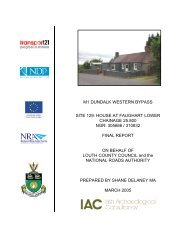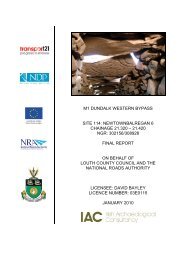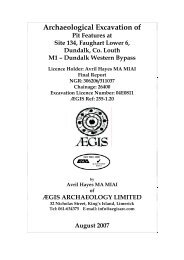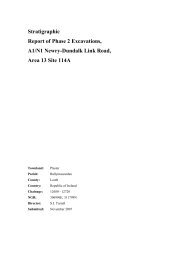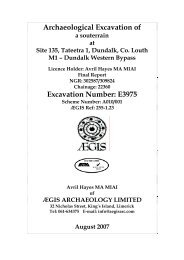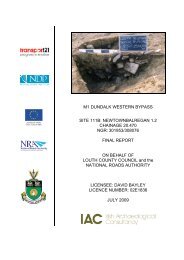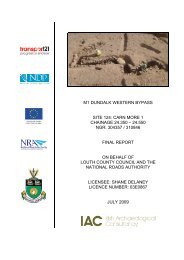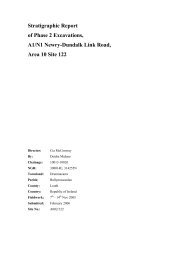Faughart Lower 5 Final Report - ASI Louth
Faughart Lower 5 Final Report - ASI Louth
Faughart Lower 5 Final Report - ASI Louth
Create successful ePaper yourself
Turn your PDF publications into a flip-book with our unique Google optimized e-Paper software.
M1 Dundalk Western Bypass<br />
Site 132 <strong>Faughart</strong> <strong>Lower</strong> 5<br />
<strong>Final</strong> <strong>Report</strong><br />
been truncated. All the pits or postholes contained sherds of Early Neolithic Carinated<br />
pottery (Appendix 2.1).<br />
The curve formed by the regularly-spaced pits [C6], [C8], [C10] and [C14] was<br />
tentatively interpreted as the possible partial remains of a circular structure. While this<br />
is not inconceivable, it should be noted that these pits contained only single fills – no<br />
postpipes were recorded – and the only evidence for possible stone packing came<br />
from pit 4, a feature internal to the arc. An alternative explanation is that the line<br />
formed by these pits is accidental or is at least non-structural, and that the features at<br />
<strong>Faughart</strong> <strong>Lower</strong> are the remains of a small group of pits dug separately or at the same<br />
time and then filled. The <strong>Faughart</strong> <strong>Lower</strong> pits contained dark, charcoal-rich or peaty<br />
fills. This, together with the worn and fragmented pottery inclusions (Appendix 2.1)<br />
and the hazelnut shells from Pit 14, suggest that the pits were filled with deposits of<br />
domestic or midden material. It would appear that the source of this midden material<br />
was located some distance away: all other potential contexts on the site were<br />
thoroughly investigated and found to be non-archaeological. Moreover, the pits at<br />
<strong>Faughart</strong> <strong>Lower</strong> 5 lay within a topsoil-stripped and archaeologically monitored corridor<br />
on average 100m wide (ibid.).<br />
Seemingly isolated Early Neolithic pits have been recorded further south, along the<br />
route of the M1 Drogheda Bypass. At Balgatheran 2, Co. <strong>Louth</strong>, a scatter of small pits,<br />
hollows and shallow deposits produced varying amounts of early Neolithic pottery,<br />
flint, burnt bone, burnt stone, charcoal and charred hazelnut shell. One feature also<br />
yielded some charred cereal grain (Campbell 2002a). At Mell 6, Co. <strong>Louth</strong>, on the<br />
north-facing slope of a limestone ridge, a shallow, oval pit was found to contain a fill of<br />
dark grey-brown soil, as well as charcoal, a large fragment of a possible granite maul,<br />
several heat-cracked stones and several sherds of Early Neolithic Carinated pottery<br />
(Campbell 2002b; Kieran Campbell, pers. comm.). None of these sites yielded other<br />
discernible features in the vicinity. Of course, given that most of the above sites have<br />
been uncovered along relatively narrow road takes or pipeline corridors, we may<br />
never know how separate or isolated this activity really is.<br />
Pit digging and deposition was a common practice in the Irish early Neolithic. A recent<br />
review of Neolithic material listed in the Excavations Bulletin from 1970 to 2002 shows<br />
that sites producing pits were at least as common as sites with evidence for houses<br />
(Smyth 2007; in prep). Pits have been uncovered in river valleys and in coastal<br />
sandhills, and across limestone ridges and hilltops. They may occur singly or in<br />
clusters, with or without associated structural features or occupation evidence.<br />
Generally speaking, many of the pits found in clusters or singly across other parts of<br />
the landscape are located in the very same low-lying, gently undulating terrain as that<br />
chosen for the early Neolithic timber houses. Both isolated pits and those associated<br />
with houses also commonly contain ‘simple’ fills of silty sand/clay flecked with<br />
charcoal, burnt/unburnt stone and hazelnut shell fragments, with occasional pieces of<br />
pottery and lithics. However, there are slight indications that pits located away from<br />
the Early Neolithic houses yield more artefacts, e.g., more sherds of pottery and<br />
worked flint. Forty-seven sherds of Early Neolithic Carinated pottery came from a pit at<br />
Kerlogue, Co. Wexford, 26 sherds from the pit at Oldbridge 1, Co. Meath, while<br />
approximately 50 sherds of pottery were recovered from the cluster of pits at<br />
Balgatheran 2 (McLoughlin 2004; Campbell 2002c, 2002a). The pits from <strong>Faughart</strong><br />
<strong>Lower</strong> 5 certainly fit in with this emerging trend. Such amounts of material may not be<br />
very substantial, but they still contrast with the fills of pits associated with most early<br />
17<br />
Irish Archaeological Consultancy Ltd



